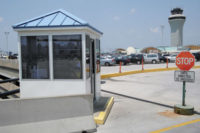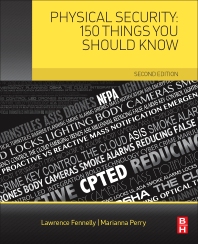Sentries to Officers: Guardhouses Diversify

Some designs can provide vehicle access control, such as this one at the Minneapolis Airport parking facility.





Do you think that keys and locks are the oldest man-made security tool? Forget it.
Guardhouses go back hundreds, if not thousands of years as a place a person would sit or stand, observe, control access, alert others and take occasional action such as dumping hot oil over the wall. These permanent and temporary structures, built in or brought in, are used in most every country.
Makers of today’s guardhouses, which come in myriad sizes, looks, inside and outside additions and technologies, most often call them modular or preassembled buildings.
On the government side, and often at diplomatic facilities, modular buildings provide pedestrian access control. At more typical enterprises, the structures house officers who handle vehicle and people access.
Specialized Needs
Some guardhouses can meet Americans with Disabilities requirements, most often for officers or personnel who handle parking fee duties.
Then there are the structures that are bullet-resistant rated. In selected cases, such as nuclear energy plants and refineries, the structures are further protected. Other structures are built and equipped for biohazards or for handling incoming mail processing.
Contract guarding firms can influence the staffing of the enclosures.
According to Jason Hatfield of Andrews International, there are two major needs of the buildings. One supports the operational function of the facility, in distribution, for example, to move products and vehicles in and out, he says. The second purpose is traditional access control and perimeter security. It is important that, in either case, the guardhouse is properly positioned, how it is placed on the grounds. When it comes to vehicles, positioning and procedures should be in place to ensure there is no slowdown or backup onto pubic streets, for example. In many applications, there needs to be a 360 degree view of the building perimeter, he notes. Glass-to-glass corners can maximize a work area to its full potential. The glass-to-glass corners with polished edges are sealed with clear silicone for water tightness. This 360-degree view offers a nice clean look with no corner post.
Also, when it comes to integrating a guardhouse with vehicle access control, some enterprises, government agencies and military facilities employ Vehicular Access Control, Entry Denial and Intrusion Detection technologies and procedures. This functionality does not stop at the guard booth; a successfully designed secure perimeter uses many products to accomplish the task, according to Michael Yobe of Smith & Wesson Security Solutions, with guardhouses, barriers and electronic monitoring. There are active and passive barriers, over speed and wrong way detection systems, under vehicle scanners and license plate readers, as examples.
While structures may be permanent, there are occasions when there is a need for a temporary solution. When it comes to retail, for example, seasonal fluctuations in delivery flow may call for a second truck gate, says Hatfield.
Jeremy Andrews of Delta Scientific sees a lot of interest in what goes into and around the guardhouses. While it all depends on the end user, there can be bathrooms, countertops, cabinets, conduit and raceways, barrier walls in front of the buildings. Remember, most security executives are less concerned about what is on the secure side of the facility, he says.
High Security Requirements
High-security booths are used at border stations, federal and state buildings, military bases and other areas where there is a high need to keep out unauthorized visitors. Bullet-resistant booths should be tested and certified to conform to Underwriters Laboratories standard UL 752 and others as required. See “Levels of Bullet-Resistance Structures” on www.securitymagazine.com.
Of course, booths must protect against more common elements than bullets. For example, the Minneapolis/St. Paul International Airport required 18 new parking/cashier booths to handle its doubled parking capacity. To architecturally complement the new parking structure, the booths feature rounded corners and custom paint design. To guard against the Minnesota winters, each booth features two heaters and double insulation. Glass can be tinted to eliminate sun glare.
After incidents of mailed-in threats such as anthrax and ricin, booth makers have introduced self-contained, prefabricated, pre-wired and UL-listed biohazard mail screening booths for inspectors to safely receive and open mail, isolating the rest of the staff and facility from exposure if bio-hazards are delivered. Such equipment is typically installed outside of a main building or inside a shipping and receiving warehouse.
Yet, no matter the need or application, one charm of guardhouses is the ability to choose from numerous options and custom designs. Long-time companies such as Par-Kut and Porta-King offer guardhouse drawings and designs to suit just about every application. These and some other sources even encourage enterprise security leaders to submit a sketch.
While auto CAD can sometimes be used in customized designs, Building Information Modeling or BIM is growingly popular. BIM is used in more than 50 percent of his company's builds, says John Millet, Jr., of Austin Mohawk, which has guardhouses as well as specialty products such as canopies, often placed over a guardhouse for lighting requirements. By the way, 3D-oriented BIM is the process of generating and managing building data during its life cycle and can involve representing a design as objects – vague and undefined, generic or product-specific, solid shapes or void-space oriented, that carry their geometry, relations and attributes. BIM design tools allow for extracting different views from a building model for drawing production and other uses. These different views are automatically consistent - in the sense that the objects are all of a consistent size, location, specification – since each object instance is defined only once, just as in reality.
In addition, weather conditions are deciding elements for some end users and locations.
That is apparent from this past spring’s tornado activity. In April, for instance, an EF4 tornado struck the St. Louis metropolitan area at Lambert International Airport, completely shutting down the facility. However, Durasteel and Durasteel prefabricated buildings – parking attendant and guard booths from Porta-King – remained intact with minor paint abrasion and glass damage due to flying debris.
Looking for a reprint of this article?
From high-res PDFs to custom plaques, order your copy today!












